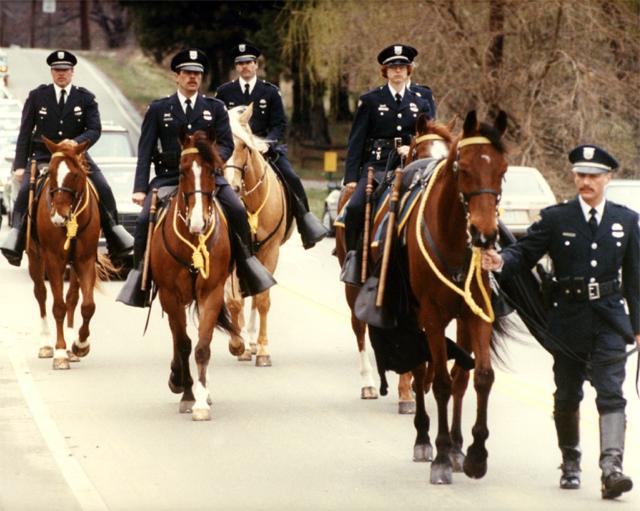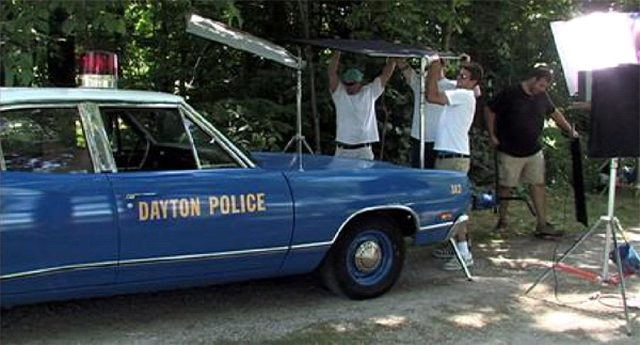Dayton Mounted Patrol
1894 - 2003

By 1894, a mounted patrol unit, consisting of eight patrolmen on horseback, had been fully introduced allowing officers to cover their beats better, longer and over a wider area. The 1897 annual report clearly shows a great deal of funds expended on the care of horses. The mounted patrol unit had recently become an added patrol feature, along with the patrol wagon and ambulance wagon. Horses carrying uniformed patrolmen were commonly seen maintaining order around the streets of Dayton.
In 1899, a mounted Dayton police officer was killed in the line of duty. Ptl. William Dalton, chasing a panhandler while on horseback, was thrown from his horse and killed as he maneuvered between two wagons.
In the mid-1910s, the horse-mounted officer was disappearing as a means of downtown patrol because, with the passing of time, bicycles and then motorized vehicles were becoming the more prevalent forms of mobile patrol.
In December 1989, the Dayton Police had the grand opening of its horse stable on Monument Avenue in Ottawa Yards, thus restoring the Mounted Patrol Unit 75 years after the original unit had been phased out. The stable provided state of the art stalls for the horses, hay and equipment storage, wash racks, tack room, laundry room and office space.
The primary purpose of mounted patrol was to provide high visibility police presence in the downtown Central Business District. Due to the height of the horses, the officers could see over crowds, vehicles and other objects. At the same time, the officers were easily seen by citizens because the horses stood far above pedestrians and cars. Horses were also an effective means for moving protesters and controlling crowds at large community events.
Having horse patrol downtown had public relations benefits. The horses were very popular with the general public and drew police officers and community members together… a trusting interaction with the citizens developed. In addition, mounted officers and their horses participated in parades and other public events that helped improve police-community relations.
The Mounted Patrol Unit served the Dayton community for 14 years before being disbanded in February 2003 due to manpower demands and other cost considerations. The mounted patrol stable is still in use as an auxiliary office complex for the Central Business District.
Dayton Bicycle Patrol
1897 - 2008

The year was 1880 and automobiles had not yet appeared on the scene. Another form of wheeled transportation, the bicycle, was all the rage. Frustrated with dirt roads that often became impassable after the lightest rain, early cyclists were among the first to organize to improve and pave America's highways.
Since 1897, bicycles had been in use to some extent by the police force because of the growing need for a mobile patrol force; by 1914, precinct sergeants were making their rounds on bicycles and patrolmen with beats in outlying areas were using bicycles so that they could more efficiently cover the greater distances from the downtown area.
Although a valuable method of patrol in the early 1900’s, it gradually disappeared, as did the horse patrol, with the advance of motorized patrol vehicles in the 1920’s.
In May of 1990 the bicycle patrol was reborn. This new Bicycle Patrol Unit started with 20 officers who rode Cannondale bikes the entire shift no matter what the weather. Many of the officers were assigned to the downtown area, augmenting or sometimes replacing walking patrol assignments.
Every district would have several trained bicycle officers that could be placed into service to patrol neighborhoods that had special crime problems. Unlike the mounted patrol, bicycle patrol still is being conducted by Dayton police officers today.
Dayton Police Patrol Cars
1969, ’71 and 1990s

This is a Dodge Coronet reproduction Dayton Police Cruiser. It was used in the filming of the independent movie “Circumstances of Fate”.
The white over blue color, as seen with the 1969 Dodge Coronet, became the standard Dayton police cruiser color design for nearly to 20 years. The top was painted white to help reduce the sun’s heat that the darker color absorbed. The shade of blue on the Coronet is the actual paint lot color used in 1969.
The 1971 Dodge Polara police cruiser was Dayton’s first air conditioned cruiser. In order to afford air conditioning, the City of Dayton had to find a way to cut costs… so the Polara had a smaller engine than it should have had for the amount of time the engine would run every day. When stationary in the summer (e.g. when officers were writing accident reports) patrolmen had to raise the hood to increase the air flow to the engine so it would not overheat while the air conditioning operated.
By 1990, the distinctive ‘white over blue’ color of Dayton police cruisers that had been its paint scheme since the early ‘70s was replaced by all-white police patrol cruisers with new markings and light bar. Where previously the City of Dayton seal appeared on the side of the cruiser, the Dayton police badge appeared. The striping was reflective and “Emergency Dial 9-1-1” was promoted on the newly design vehicle. Double-bubble lights were replaced with the newer “VisiBar” lights.
Return to Dayton Police History Home Page